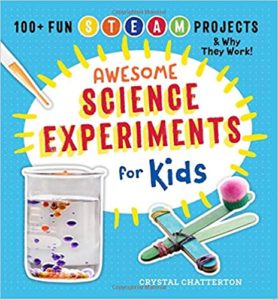This is one of my favourite experiments. I chose it because it is a great S.T.E.M. game and it is also one we can all do at home, since all you need is a plastic Ziploc bag, a few pencils and some water. It is so fun to watch the children’s reaction when they pierce the bag with the pencil, expecting all the water inside to come pouring out, and instead finding that not a drop spills out! How can that happen, you ask? Polymer chains work together to prevent water from leaking out of the bag.
Best Ages for This Activity
This activity is great for three to five-year-old children (or older).
How to Make It
Ingredients
- Water
- A few pencils – three or four are fine, but you can do more if you wish, or you can try with just one if that is all you have.
- A pencil sharpener
- A medium Ziploc bag or use any containers with tight lids you have around the house
- Uncooked pasta noodles of any shape and size
- Packets of Kool-Aid
Let’s Get Started!
- Find a workspace where children expect a giant mess (outside on the grass, or above the kitchen sink, or in your bathtub)
- Sharpen your pencils very well (of course, this is something your child can do). Make sure all the pencils are sharpened to a point or it won’t work.
- Fill the bag with water and seal it closed (1/2 the bag should be full of water when closed. No need to fill to the top).
- Invite your child to form a hypothesis by saying: “I wonder what will happen if we pierce the bag with this pencil” – you can write down their hypothesis (for example, the water will pour out of the bag, or whatever they think will happen)
- Here comes the fun part: while you (or your child) hold the bag up by the top, your child can slowly pierce a pencil through one side of the bag and halfway out the other side (like in the picture). You can ask “What happened?”
- Much to your child’s amazement, you will see that the pencil can go right through without leaking a drop of water!
- What actually happened, though? How is it possible? The long chains of molecules that make up the bag (they are called polymer chains) actually seal back around the pencil and prevent water from leaking out. Magical! – see below for a more elaborate explanation.
- Now try putting another pencil through, and another! You can put lots of pencils through.
Learning Opportunities
Children will learn S.T.E.M. while trying this science experiment. Questions you can ask your child during the experiment are:
- How is it possible for the water to stay in the bag after we pierced the bag with a pencil?
- Why is the water not leaking out?
- What happens if we take the pencil out? (save this one for last as this will be the end of your experiment – bye-bye water)
Here is what actually makes this possible:
The Ziploc bag you used, like many plastic bags, was most likely made out of a polymer called low-density polyethylene, which is very flexible. When you push a (sharp) pencil through, these long, flexible polymer chains (strands) get pushed apart by the pencil, but don’t break. Instead, they re-seal around the pencil.
By doing this experiment mostly on their own, children can form many hypothesis of what will happen, why it will happen, what will happen next, etc. This is how they learn science. As they are following all the steps, they are learning sequencing, which is great for reading as well as math.
CEFA tip: Remember to let your child do as much of the process as they are capable of.
Things to Keep in Mind
- Make sure you are doing this experiment outside or over a sink, as the water may spill! Also keep in mind that the pencils are sharp, and your child needs to be supervised.
Extended Learning Opportunities
Try with different types of bags (for example, grocery bags, or very thick produce bags) and follow the same scientific process:
- Hypothesis
- Test
- Conclusion
Now try different types of pencils (some are perfectly round while some have edges). Which pencil works best?
Books Your Child Might Like
